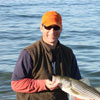5 Fly Tying Knots for Realistic Presentation
By Tom Keer
Sep 26, 2016
Catch more fish by using the right knots for fly fishing.
There are lots of knots to know for all types of fishing. When it comes to knots for fly fishing, many that you already know are useful. Add a few specialty fly tying knots to help your presentation and you're good to go. Here are five that will help you present your flies more realistically so you can catch more fish.
Common Knots for Fly Fishing Success
Duncan Loop
The Duncan Loop is also known as the Uni-knot. It's an ideal fly tying knot for two reasons. First, if you cinch it down it's a fixed knot. If you seat it and leave some space it'll work as a loop knot. Nymphs and streamers tied with loop knots move naturally in the current which means you'll catch more fish. When you hook up, the knot slides to the fly and seats down for the fight.
Improved Turle Knot
The Improved Turle Knot helps flies with up or down-turned ring eyes ride properly. It's used mostly when fishing dry flies as it keeps them from riding nose down. No self-respecting trout will eat a fly riding nose down....
Improved Clinch Knot
For tying on most flies, you can't beat an Improved Clinch knot. How can you argue with a fly tying knot that has nearly 100% breaking strength? It's great for all applications with thinner tippets.
Blood Knot
The Blood Knot is used for tying together two fishing lines of similar thickness. It's ideal for rebuilding a leader. If you leave long tag ends off you can also tie on another fly as a dropper.
Surgeon's Knot for Saltwater
It's as simple as an overhand knot that is run through one more time. The Surgeon's Knot is used for building a leader while the Surgeon's Loop excels as a fly tying knot for tying on a fly.
To maintain knot integrity and reduce friction when seating the fly fishing knot, add water or saliva to the monofilament. Pull steadily, and avoid a jerking motion that stretches the fishing line and lessens the breaking strength. Add water, and catch 'em up. But first, learn a few more knots for fly fishing! Fly Fishing knots! But first, learn a few more knots for fly fishing!
Common Knots for Fly Fishing Success
Duncan Loop
The Duncan Loop is also known as the Uni-knot. It's an ideal fly tying knot for two reasons. First, if you cinch it down it's a fixed knot. If you seat it and leave some space it'll work as a loop knot. Nymphs and streamers tied with loop knots move naturally in the current which means you'll catch more fish. When you hook up, the knot slides to the fly and seats down for the fight.
Improved Turle Knot
The Improved Turle Knot helps flies with up or down-turned ring eyes ride properly. It's used mostly when fishing dry flies as it keeps them from riding nose down. No self-respecting trout will eat a fly riding nose down....
Improved Clinch Knot
For tying on most flies, you can't beat an Improved Clinch knot. How can you argue with a fly tying knot that has nearly 100% breaking strength? It's great for all applications with thinner tippets.
Blood Knot
The Blood Knot is used for tying together two fishing lines of similar thickness. It's ideal for rebuilding a leader. If you leave long tag ends off you can also tie on another fly as a dropper.
Surgeon's Knot for Saltwater
It's as simple as an overhand knot that is run through one more time. The Surgeon's Knot is used for building a leader while the Surgeon's Loop excels as a fly tying knot for tying on a fly.
To maintain knot integrity and reduce friction when seating the fly fishing knot, add water or saliva to the monofilament. Pull steadily, and avoid a jerking motion that stretches the fishing line and lessens the breaking strength. Add water, and catch 'em up. But first, learn a few more knots for fly fishing! Fly Fishing knots! But first, learn a few more knots for fly fishing!
Popular Posts









